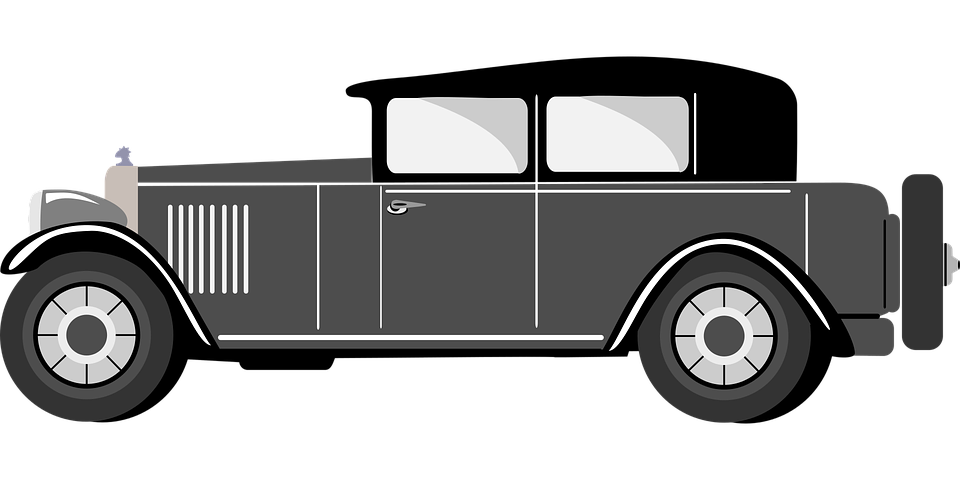


Mobile users:
For best results, view in Landscape mode.
With the turn of a key or push of a button, people
take for granted starting a car today.
The modern starter motor is a direct current electric motor
with a solenoid switch that is similar to a relay on it.
When the low-current power from the starting battery is applied
to the solenoid (this is usually through a key operated switch),
it will push out a small pinion gear on the starter motor’s
shaft and meshes it with the ring gear on the flywheel of
the engine.
The solenoid will also close high current contacts for the
starter motor and it will start running.
Hand cranks were the most common type of engine
starters in the early days of the automobile.
The term “cranky” originally referred to the bad mood drivers
would be in after struggling to turn the crank while starting
their car.
They were essentially crank handles that were temporarily coupled
with the engine crankshaft.
The driver would 'crank the engine' by turning the handle, which
would allow the process of internal combustion to begin.
After a given number of cranks, the engine would begin to run
on its own, and the crank could be removed.
Hand cranking a car was also dangerous.
Many injuries and deaths resulted from engine backfires or
when a car lunged toward the crank if it was left in gear.
It took a great deal of physical effort to turn a hand crank starter,
and anyone who lacked the necessary physical strength
or dexterity was unable to start a car without assistance.
In early 1908, a woman stalled her Cadillac in Detroit, Michigan.
She did not have enough strength to crank the engine to
restart it.
A passing motorist offered to help. His name was Byron Carter
and he just happened to be a friend of Cadillac founder
Henry Leland.
So Carter cranked the Cadillac's motor and it backfired.
The crank hit him in the face breaking his jaw.
Carter was admitted to hospital and later died.
Carter's death led Leland to vow that Cadillac would rid its cars of
the hand starter crank.
And so he called on Charles Kettering who owned Dayton
Engineering Laboratories Company ( DELCO ).
In 1911, Charles F. Kettering, with Henry M. Leland,
of Dayton Engineering Laboratories Company (DELCO),
invented an electric starter in America.
The starters were first installed by Cadillac
on production models in 1912.
In 1919, DELCO was bought by General Motors (GM)
and Kettering became GM's head of technology.
The Ford Model T relied on hand cranks until 1919.
By 1920, nearly all manufacturers were producing cars equipped
with starters making it easy for anyone, regardless of
physical abilities, to start a car by pressing a button
mounted on the dash or floor.
By the 1920's, electric self-starters would come standard
on nearly every new automobile, making it easier for women
and elderly people to drive.
Within 5 years self starters would come standard on nearly
every new automobile.
By making cars easier and safer to operate, especially for
women, the self-starting engine caused a huge jump in sales.
These starters also worked as generators once the engine was
running, a concept that is now being revived in hybrid vehicles.
Even though the electric self-starter was Kettering’s most
famous invention, he also played a role in developing
variable speed transmissions, high compression engines,
and quick-drying automotive paint.
The 1946 Dodge Deluxe dash-mounted button activated
a solenoid, which in turn engaged the starter.
Before 1949, the starter was often operated by the driver
pressing a button mounted on the floor or dashboard.
In 1949, Chrysler introduced the modern key that starts
the car with a turn of the ignition tumbler.
This also was a safety innovation, since the starter
button made it easy for children to inadvertently
start the car while it was still in gear.
Some cars had a pedal in the floor that manually engaged
the starter drive pinion with the flywheel ring gear, then
completed the electrical circuit to the starter motor once
the pedal reached the end of its travel.
In 1965, Ford introduced its double-sided key still used in
many of today's cars.
Unlike the single-sided keys preceding it, this one has cuts
on both sides, allowing it to be inserted into the tumbler in
either orientation.
The key starter remained the only way to start a car until
1998, when Mercedes-Benz introduced “Keyless Go” on the
fourth-generation S-Class.
Keyless ignition systems first began appearing on production cars
in the late 1990's and early 2000's, and like many tech
and convenience features, they were initially available only on
luxury models and other high-end vehicles.
In 2003, General Motors offered the first fully integrated,
factory-installed and guaranteed remote control starter
on vehicles.
GM took the initiative in remote control starter systems, and
the company was installing them in numerous high-end
and mid-range models by 2008.
In 2007, Subaru began offering factory- installed remote starters
as an option on several models.
In 2010, Subaru joined several other car manufacturers in
providing all-in-one key-less entry and starter systems
on its higher end models.
A remote starter is a radio controlled device, which is
installed in a vehicle by the factory or an aftermarket
installer to preheat or cool the vehicle before
the owner gets into it.
Once activated, by pushing a button on a special key chain
remote, it starts the vehicle automatically for a
predetermined time.
Most of today's cars operate with a push-button
starter, which requires that a "key fob" be in proximity
for the starter motor to activate.
A key-less system permits starting a car without a physical
key being inserted into an ignition. Instead, a small device
known as a "key fob" transmits a code to a computer
in the vehicle when the fob is within a certain
close range.
